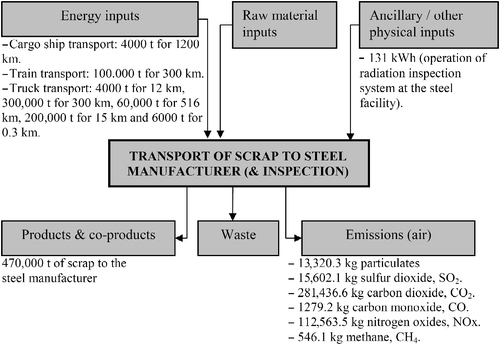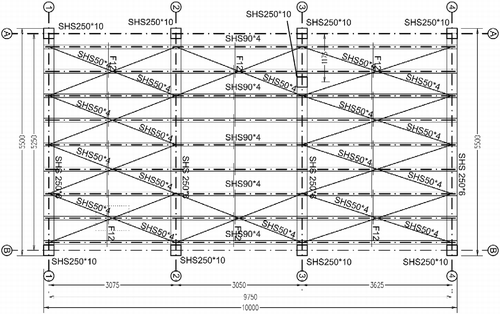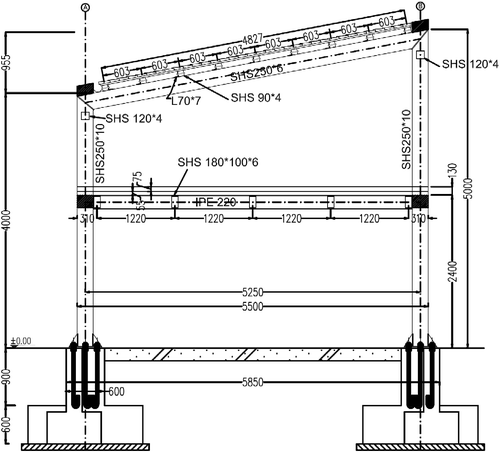Abstract
The construction industry is a critical sector in relation to sustainable development as its optimisation in terms of the consumption of resources can provide significant environmental benefits. To achieve this, a number of tools and methodologies have been developed to assist decision making. Life cycle assessment is one of the most acknowledged and widely used methodologies to assess the sustainability of construction works. Its efficient use, however, requires environmental data that in some cases are not yet available. Especially for sectors such as steel construction in which the potential for sustainable development is increased due to the recycling and reuse potential of the material, the lack of such data slows sustainability-related progress down. The current research addresses this issue by collecting primary environmental data for cold-formed structural steel and compiling the required data-sets. The data-sets are used to assess the environmental impact of an existing steel building and identify how and to what extent the environment is burdened by its construction. The findings of the research include the aforementioned environmental data which can be used in environmental analyses related to construction projects, while additional conclusions concerning the environmental impact of steel buildings in terms of quantity and type were also drawn.
1. Introduction
The construction sector has marked significant growth during the last decade both in terms of project scale and delivery capability. Impressive and ambitious architectural designs that require innovative structural solutions are being constructed and eventually receive the attention and admiration of peers and society. However, as sustainable development is rightfully being promoted as the most urgent priority concerning human activity (Commission of the European Communities Citation2009), it has revealed the large amounts of energy and materials that are consumed by construction activities (Ortiz, Castells, and Sonnemann Citation2009). As a result, pressure is now being applied to the whole of the construction industry to respond to the challenge of sustainable development and minimise impacts on the environment (Oti and Tizani Citation2011).
To achieve this, it has been shown that measures have to be taken as early as possible in the project delivery process (Trumpf et al. Citation2007). Decision making that takes place during the very first project stages will have a major and also irreversible effect on the environmental impact of the whole project. One of the tools which has been developed to aid such critical decisions (Landolfo, Cascini, and Portioli Citation2011) and is currently widely used globally is the life cycle assessment (LCA) methodology. Its application is based on the concept of the life cycle which for the case of construction works consists of four stages, namely raw material acquisition, construction, use/maintenance and demolition/disassembly. In order to assess the environmental impact caused during each of these stages, it is necessary to use environmental data called life cycle inventory (LCI) data which quantify the impact of particular processes and materials the use of according to inputs and outputs from/to the environment. Such data can be found in existing LCI databases and can often be used for several cases (Curran and Notten Citation2006). Construction, however, is a case for which such data can currently only be found in scarcity.
This limited data availability is an obstacle to the construction sector's sustainability. Especially in the case of steel construction which is characterised by increased sustainability potential (Burgan and Sansom Citation2006) due to the capability of steel for recycling and reuse (Yellishetty et al. Citation2011; Hillier Citation2011), this lack of environmental data hinders the application of LCA significantly. When most construction materials are usually disposed of in landfills at the end of the service life of a project, steel components can be easily retrieved and sent for recycling or reuse in another project. With current structural steel recycling rates well above 80% of the initial quantity used, it is necessary to enable the quantification of the environmental impacts that can be derived by recycling or reusing steel and thus avoiding the extraction of new quantity of raw materials or the whole manufacturing process altogether.
Within the construction sector, the sustainability of construction technologies and products is usually described and presented in a general manner which often does not contain any valid calculation of environmental benefits. With the introduction of LCA, however, this is about to change; every construction product must now be accompanied by a calculated inventory of its environmental impact and potential benefit in order for its sustainability to be validated. For steel construction, this is essential, as only this validation can highlight the sustainability of steel and ultimately provide a competitive advantage in comparison to other construction materials.
The current research aims at contributing towards this direction by developing LCI data-sets referring to one of the most commonly used structural steel member types used in construction, namely cold-formed hollow steel sections. This type of data-set, including the process for cold-formed of the steel sections, is currently unavailable in other existing LCI databases, since even the LCI databases that do contain data on steel construction usually focus on the steelmaking process or other steel manufacturing processes such as hot rolling. The methodology according to which these data-sets were created is presented, along with an application to an existing steel residential building for which the environmental impact of its construction is assessed.
2. Methodology
Cold-formed hollow steel sections such as square hollow sections (SHS) or rectangular hollow sections (RHS) constitute a type of structural steel member which is very often used in construction. These sections are used not only for traditional steelwork to form the main structural system but also for a number of other purposes such as the support of cladding materials used in renovation projects. They are, therefore, selected as the component for which environmental data would prove most useful with respect to the application of LCA.
The development of the relevant LCI data-sets to be used in LCA studies requires the detailed documentation of processes necessary for the production of the cold-formed steel sections as the first step forward. These processes have to be examined not only in terms of sequence but also in terms of inputs and outputs to the environment (Zygomalas, Efthymiou, and Baniotopoulos Citation2009). Substances required and emitted during each process must be documented and categorised accordingly. A review of the market conditions surrounding the manufacturing of structural steel products showed that there are three major steel manufacturing companies that are active in this business sector within the Greek region. The data used in this research were obtained by contacting these steel manufacturing companies – which collectively hold the largest market shares in Greece – and complemented by existing literature when necessary.
The material supplied contained detailed information on the manufacturing processes for structural steel, including cold-formed hollow sections. Based on this material, the manufacturing processes for cold-formed hollow steel sections were analysed and grouped in sequence and also in terms of environmental inputs (raw materials and energy) and outputs (emissions to air, water, soil and waste). For each manufacturing process, an LCI data-set was created and then used to compile a collective data-set for the cold-formed sections.
The data collected refer to the production of cold-formed sections via the electric arc furnace (EAF) steelmaking route. As verified by the World Steel Association (Citation2009), all steel produced in Greece is manufactured with this process. EAF steelmaking produces steel from the melting of iron and steel scrap, and then processes it to achieve the desired properties for structural use. This method does not require the extraction of new quantities of raw materials as is the case with the other main steelmaking route, namely the basic oxygen furnace (BOF). This is also one of the main characteristics of the status of the Greek steel construction industry with regard to sustainability, given that the environmental policies that are currently in force have not yet been updated to include recent European regulations and guidelines.
In order to demonstrate the use of the compiled LCI data-set for cold-formed hollow steel sections, an environmental impact assessment is also conducted for a steel residence in Greece. The assessment is carried out according to two widely used methodologies, namely Eco-Indicator 99 and CML 2 baseline 2000. The Eco-Indicator 99 methodology provides a detailed account of the quantity and type of environmental impact caused by the construction of the steel house, including easily recognisable indicators such as ‘climate change’, ‘respiratory inorganics’ (referring to the consequences on human health) and ‘fossil fuels’. On the other hand, the CML 2 baseline 2000 methodology includes indicators such as the global warming potential (GWP), ozone layer depletion (ODP) or acidification which – in contrast to Eco-Indicator 99 – are expressed in default units that allow for the comparison of the results to other analyses. On the whole, the use of these two methodologies provides both a detailed account of the environmental impact caused and the comparable values of environmental impact assessment.
2.1 Goal, scope and functional unit
The environmental data-sets concerning the structural steel sections were developed according to the relevant International Organization for Standardization (ISO) standards, namely ISO Citation14040:2006 and Citation14044:2006. The guidelines included in these documents require the definition of certain parameters which will affect the manner in which the LCI data-sets are to be developed. The first parameter that has to be defined is the goal of the LCA studies in which the data-sets will be used. The goal of such studies is the assessment of the environmental impact caused throughout the life cycle of a construction project which includes cold-formed hollow steel sections.
The scope covered by the data-sets is ‘cradle-to-gate’ and ranges from the processes required for the acquisition of the necessary raw materials to the storage of the steel sections at the manufacturer before they are sent for use. The production and maintenance of the machinery used for the production of the steel sections are not included in the calculations.
The geographic coverage of the developed LCI data-sets is mainly Greece but can be expanded to the wider European region for countries that utilise the EAF steelmaking route exclusively or in combination with the BOF route. It is also possible to make adjustments to the data-sets in order to reflect a certain country's conditions. In order to facilitate the use of the data-sets in other LCA studies, the functional unit selected for the current analysis is the production and storage of 1 kg of cold-formed hollow structural S235 steel quality members.
3. LCI documentation of production processes
Each production process concerning the cold-formed steel members has to be analysed in terms of environmental inputs and outputs. The documentation of the main production stages was based on the data obtained from the steel manufacturers in Greece and is presented in Figure .
For each of the main production stages, environmental inputs and outputs were calculated and also presented in flow diagrams according to the specifications in ISO Citation14044:2006. An example of the methodology used for the LCI analysis of the production stages is presented for the first one, the transport of the scrap to the steel manufacturer.
3.1 Transport of scrap to steel manufacturer
EAF steelmaking uses iron and steel scrap as the main raw materials to produce new quantities of steel. The scrap used for this purpose in Greece is transported to the steel manufacturer facility in trucks or by train from inland suppliers or abroad. Certain quantities come from the facility itself as the scrap is constantly being returned from inside production units. For the LCI analysis of the transport of scrap to a steel manufacturer in Thessaloniki, the data with respect to the origin, quantity, means of transport and distance covered were documented as presented in Table . These data refer to the scrap transported to a specific manufacturer in Greece for the year 2008.
Table 1 LCI data with respect to the transport of scrap.
Based on these data, the environmental inputs and outputs are calculated for the transport of scrap to the steel manufacturer. The process of the inspection of the incoming scrap for radiation at the factory gates is also included in the calculations. Figure shows the main results according to the specifications in ISO Citation14044:2006. Such diagrams were calculated for each of the production stages of the steel members.
3.2 Secondary data
For the calculations of the environmental inputs and outputs of each production stage, a number of processes found in existing LCI databases were used as secondary data. This category of data refers to processes, such as transport or energy, which are not the main object of this study but are still necessary for the completion of the calculations. In Table , these processes are listed along with a set of their main characteristics, including their source database, the reference year in which they were created and last updated and their geographic coverage. The data-sets of the current analysis in which these secondary data processes were used are also listed.
Table 2 Secondary data used for the LCI study of cold-formed hollow steel members.
4. Environmental data
Based on the analysis described, environmental input and output results are calculated for the manufacturing of 1 kg of cold-formed hollow steel sections via the EAF steelmaking route. The complete inventory lists that were obtained contain over 700 substance entries, referring to the required raw materials, the emissions to air, water and soil, and waste associated with the manufacturing processes. Data-sets were calculated for all the dimensions of sections used in steel construction projects, namely section width, height and thickness. In Table , the most influential inputs and outputs, along with the substances suggested for monitoring by the European Environment Agency (Citation2007), are presented for three cold-formed sections; SHS 100 × 5, SHS 250 × 10 and RHS 180 × 100 × 6.
Table 3 Environmental data-sets for the production of 1 kg of cold-formed structural steel (EAF) hollow members (sections SHS 100 × 5, SHS 250 × 10 and RHS 180 × 100 × 6).
These results can be used to calculate the environmental impact caused by cold-formed hollow structural steel members within any steel-related LCA study. It should also be noted that in cases where steel is recycled during a production process, the subsequent benefits have already been deducted from the total environmental impact and, therefore, no scrap quantities appear as outputs.
5. Application to an existing steel residence
The data-sets created were used to assess the environmental impact of the construction of an existing steel residential building which was mainly constructed of cold-formed structural steel elements. It is a ground-floor single residence with a steel deck and a plan view of 10 m × 5.5 m (Figures and ).
The environmental impact of the construction is assessed through the calculation of the environmental impact caused during this stage of the building's life cycle. Impact assessment results are calculated according to the environmental data compiled for the cold-formed structural steel and two methodologies, namely Eco-Indicator 99 and CML 2 baseline 2000. Each methodology provides useful results and comparable indicators concerning the environmental impact caused by the construction of the steel building.
The main construction materials required for the construction of the steel building are presented in Table and also displayed in Figure , where their differences in weight are clearly depicted. It is noted that the goal of the analysis is the assessment of the environmental impact caused by the structural elements of the building, and therefore, all other materials such as cladding or insulation are excluded. A distance of 10 km was also taken into account for the transport of the materials to the site.
Table 4 Main materials and processes required for the construction of the steel residential building.
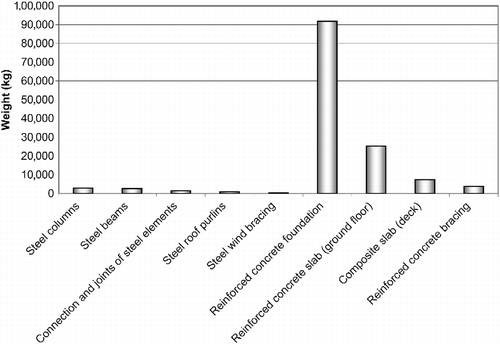
5.1 Eco-Indicator 99
The Eco-Indicator 99 impact assessment methodology (V2.08/Europe EI 99 E/E) provides a detailed analysis of the environmental indicators mainly burdened by the construction of the steel building. Environmental impact is calculated in Pt, where 1 Pt is representative of one thousandth of the yearly environmental load of one average European inhabitant (The Netherlands Ministry of Housing, Spatial Planning and the Environment Citation2000). The total environmental impact caused by the construction of the steel residential building is calculated at 2957.4 Pt. In Figure , the environmental impact assessment results are presented according to the environmental indicators used in the Eco-Indicator 99 methodology.
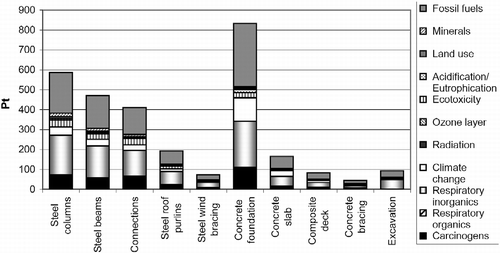
The concrete used for the foundation of the building is found to be responsible for the highest environmental impact caused (832.2 Pt), while the structural steel elements are also found to cause significant impact. Steel columns, beams and connections were found to cause 587.8, 471.3 and 410.9 Pt, respectively. The remaining materials were found to cause quite lower or negligible environmental impact. Figure also presents that the amount by which each environmental indicator used by the Eco-Indicator 99 methodology is burdened. For example, it can be observed that the environmental impact caused by the steel columns mainly burdens the ‘fossil fuels’ indicator which refers to natural resources and the ‘respiratory–inorganics’ indicator referring to human health. In order to identify the type of environmental impact caused, the impact assessment results are also presented according to each environmental indicator in Figure .
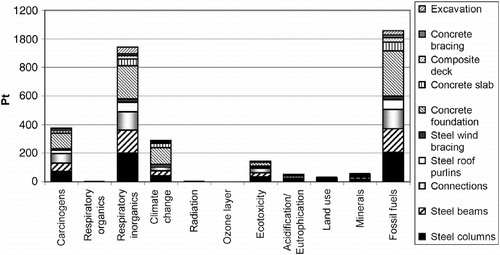
As can be observed, the ‘fossil fuels’ indicator is burdened mostly compared to the other environmental indicators. The ‘respiratory–inorganics’ and ‘carcinogens’ indicators referring to human health also accept significant environmental loads. ‘Climate change’ and ‘Ecotoxicity’ are burdened to a relatively lower yet noticeable degree, whereas the rest of the indicators accept negligible burden. It is, therefore, shown that the construction of the steel building mainly affects natural resources and human health.
5.2 CML 2 baseline 2000
The CML 2 baseline 2000 (V2.05/World, 1995) is another impact assessment methodology which provides useful results for the quantification of the environmental impact caused by the construction of the steel building. The results obtained are presented in Table and contain some of the indicators often used in LCA studies.
Table 5 Impact assessment results for the construction of the steel residential building according to the CML 2 baseline 2000 method.
As can be observed, the GWP indicator (GWP 100) for a 100-year time period was calculated at 40,837.1 kg of carbon dioxide equivalent to the construction of the steel building.
6. Conclusions
The construction sector has been associated with the consumption of large amounts of energy and materials and as a result, pressure is being applied to construction professionals to minimise the impact of projects to the environment. Decision making in the very early stages of a construction project plays a critical role in pursuing such an orientation and methodologies such as LCA constitute useful tools to approach this issue.
LCA is a detailed and acknowledged methodology to quantify environmental impacts throughout the life cycle of a construction project. Its use, however, is currently hindered by the scarcity in which the LCI data that are required for its valid application can be found in available databases. Particularly in sectors such as steel construction where the potential for sustainable construction is increased due to structural steel's ability for recycling and reuse, this lack of available data stands in the way of achieving sustainability.
The research presented contributes to reversing this situation with the development of new environmental data for one of the most commonly used type of structural steel members, namely cold-formed hollow steel sections. Based on primary data obtained from structural steel manufacturers in Greece and according to the specifications of the relevant ISO documents, a range of data-sets is made available for use in environmental analyses related to construction projects. A list of substances that were calculated as the main environmental inputs and outputs for the manufacturing of the cold-formed hollow sections were presented, while minor modifications can even enable the used data-sets in other countries or regions. In case the manufacturing processes for the steel sections are the same (EAF steelmaking and cold-forming of the sections), the data-sets could be used in other countries if the environmental data concerning the consumed energy would be changed to fit the specific country's energy production mix.
The environmental data that were compiled were applied to an existing steel residential building in order to assess the environmental impact of its construction. The results provided a detailed account of the environmental impact caused by its construction, both in terms of quantity and type. The concrete used for the foundation of the building was found to be responsible for the highest environmental impact caused, followed by the structural steel elements. In terms of the type of environmental impact caused, it was shown that the construction of the steel building mainly affects natural resources and human health.
The environmental impact assessment results that were calculated on the basis of the compiled environmental data provide a detailed and thorough account of the environmental impact caused and can, therefore, be used for the assessment of the environmental impact of construction projects in order to decide between alternative designs and different construction solutions.
Impact assessment results were also calculated according to two methodologies: the Eco-Indicator 99 that provides a detailed account of the environmental impact caused and the CML 2 baseline 2000 that contains a set of indicators very often used in LCA, such as the GWP indicator. In general terms, it was shown that the production of cold-formed steel sections mainly affects natural resources and human health. The manufacturing processes that were identified as mainly responsible for the environmental impact caused were the operation of the EAF and hot-rolling. Further examination revealed that the consumption of electrical energy is responsible for more than half of the total environmental impact for the manufacturing of the cold-formed sections.
Notes
1. Email: [email protected]
REFERENCES
- Burgan, B. A., and M. R.Sansom. 2006. “Sustainable steel construction.” Journal of Constructional Steel Research62: 1178–1183.
- Commission of the European Communities. Communication from the Commission to the European Parliament, the Council, the European Economic and Social Committee and the Committee of the Regions – Mainstreaming sustainable development into EU policies: 2009 Review of the European Union Strategy for Sustainable Development, COM/2009/0400 final2009.
- Curran, M. A. and P.Notten. 2006. Summary of Global Life Cycle Inventory Data Resources. US Environmental Protection Agency. Available from: http://www.epa.gov/ordntrnt/ORD/NRMRL/std/lca/pdfs/summary_of_global_lci_data_resources.pdf. [Accessed 20 December 2012].
- European Environment Agency. 2007. Europe's Environment – The Fourth Assessment. Luxembourg: Office for Official Publications of the European Communities.
- Hillier, G.2011. “Steel and Sustainability Construction Products for a Sustainable Society.” Ironmaking and Steelmaking31 (6): 440–443.
- International Organization for Standardization (ISO). 2006a. “International Standard ISO 14040:2006.” In Environmental Management – Life Cycle Assessment – Principles and Framework. http://www.iso.org/iso/catalogue_detail?csnumber=37456.
- International Organization for Standardization (ISO). 2006b. “International Standard ISO 14044:2006.” In Environmental Management – Life Cycle Assessment – Requirements and Guidelines. Available from: http://www.iso.org/iso/catalogue_detail?csnumber=38498.
- Landolfo, R., L.Cascini, and F.Portioli. 2011. “Sustainability of Steel Structures: Towards an Integrated Approach to Life-time Engineering Design.” Frontiers of Architecture and Civil Engineering in China5 (3): 304–314.
- Ortiz, O., F.Castells, and G.Sonnemann. 2009. “Sustainability in the Construction Industry: A Review of Recent Developments Based on LCA.” Construction and Building Materials23: 28–39.
- Oti, A. H., and W.Tizani. 2011. “A Sustainability Appraisal Framework for the Design of Steel-Framed Buildings.” In Proceedings of the 13th international conference on civil, structural and environmental engineering computing, Chania, Crete, September 6–9.
- The Netherlands Ministry of Housing, Spatial Planning and the Environment. 2000. Eco-Indicator 99, Manual for Designers: A Damage Oriented Method for Life Cycle Impact Assessment. Available from: http://www.pre-sustainability.com/download/manuals/EI99_Manual.pdf. [Accessed 20 December 2012].
- Trumpf, H., H.Schuster, K.Sedlbauer, and W.Sobek. 2007. “An Approach for an Integrated Design Process Focussed on Sustainable Buildings.” In Proceedings of the first workshop of COST action C25 – sustainability of constructions: integrated approach to life-time structural engineering, 0.35–0.42. Lisbon, September 13–15, Multicomp, Lda, Portugal, edited by L.Bragança, H.Koukkari, R.Blok, H.Gervásio, M.Veljkovic, Z.Plewako, R.Landolfo, V.Ungureanu, and L. S.Silva.
- World Steel Association (Worldsteel). 2009. “Worldsteel Committee on Economic Studies, Brussels.” Available from: http://www.worldsteel.org/pictures/publicationfiles/SSY2008[1].pdf. [Accessed 10 February].
- Yellishetty, M., G. M.Mudd, P. G.Ranjith, and A.Tharumarajah. 2011. “Environmental life cycle Comparisons of Steel Production and Recycling: Sustainability Issues, Problems and Prospects.” Environmental Science and Policy14 (6): 650–663.
- Zygomalas, I., E.Efthymiou, and C. C.Baniotopoulos. 2009. “On the Development of a Sustainable Design Framework for Steel Structures.” Transactions of FAMENA2 (33): 23–34.


